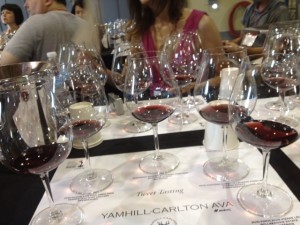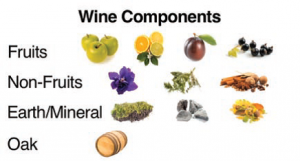The Neuroscience of Wine Tasting
 This post is a bit more technical than usual, but it is so interesting, I want to share the concept. The information here was presented by Tim Gaiser at the Wine Bloggers Conference in Portland this past August. Tim has 2 degrees in music, worked in the restaurant business for many years, and is one of fewer than 200 people in the world to achieve the title of Master Sommelier. He has been teaching people how to taste wine for more than 25 years, documenting their responses to support his research on the topic.
This post is a bit more technical than usual, but it is so interesting, I want to share the concept. The information here was presented by Tim Gaiser at the Wine Bloggers Conference in Portland this past August. Tim has 2 degrees in music, worked in the restaurant business for many years, and is one of fewer than 200 people in the world to achieve the title of Master Sommelier. He has been teaching people how to taste wine for more than 25 years, documenting their responses to support his research on the topic.
Approximately 3 years ago, Tim began working on a project to better understand how people recognize aromas and flavors while tasting wine. He had his own tasting process meticulously documented and then profiled other people’s tasting processes, using both informal and formal methodologies. Some of his findings are reported here.
Tasting wine needs to be approached methodically and it can be helpful to have an instructor or guide to lead one through the tasting process. Certain conditions are necessary for effective tasting, including adequate light, a fairly quiet room, no obvious odors in the air (perfume can really be a problem), tasting wines in batches, having wines at proper temperatures, and good glassware.
As a person approaches a wine, the color is the first thing that is noticed and it brings certain expectations in terms of the age of the wine and the grape variety. Most people learn to see the color of the wine in the context of color gradations or “swatches” that are stored in memory. Next is the smell of the wine. All people smell with a consistent starting eye position or pattern. The majority of us look down when smelling, but we may look down and to the left or right or there may be a series of rapid eye movements. Nothing is right or wrong, but research has proven that individual eye patterns are consistent. As one is smelling the wine, auditory prompts (all internal) begin to pop up – What’s there? What am I smelling? What is in the glass? What kind of fruit is it? As these questions arise and the taster starts to formulate answers, specific images and words appear, including various fruits, flowers, herbs, perhaps a wine barrel. Even more interesting is the way these images arrange themselves into maps or patterns that are unique and vary dramatically from taster to taster.
the grape variety. Most people learn to see the color of the wine in the context of color gradations or “swatches” that are stored in memory. Next is the smell of the wine. All people smell with a consistent starting eye position or pattern. The majority of us look down when smelling, but we may look down and to the left or right or there may be a series of rapid eye movements. Nothing is right or wrong, but research has proven that individual eye patterns are consistent. As one is smelling the wine, auditory prompts (all internal) begin to pop up – What’s there? What am I smelling? What is in the glass? What kind of fruit is it? As these questions arise and the taster starts to formulate answers, specific images and words appear, including various fruits, flowers, herbs, perhaps a wine barrel. Even more interesting is the way these images arrange themselves into maps or patterns that are unique and vary dramatically from taster to taster.
Another interesting finding was how these mental images changed with increases or decreases in the intensity of aromas and flavors. Bolder aromas or flavors caused images to become brighter, larger, and appear closer where weaker or diminishing flavors and aromas caused the images to fade and become more distant, less vivid. Most tasters, in evaluating the sweetness of a wine, tannins, and the wine’s finish tended to use mental images such as a ruler or scale to measure these components.
Learn more about this fascinating topic by visiting the link to Tim’s site and then experiment with your own wine tasting.
Cheers!

 Lisa Gorham
Lisa Gorham
Hi Catherine,
I love this post! I didn’t get to attend this breakout session so I’m happy that I got to have a little “taste” of it on your blog. Thank you so much for sharing this with your readers!
It was so great to meet you at the WBC12 workshop! Hopefully our paths will cross again. Until then ~ Cheers to you!
Jen Dahlin
http://virutalwinebar.com